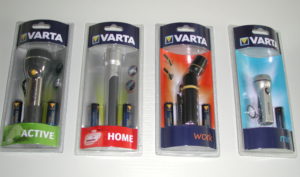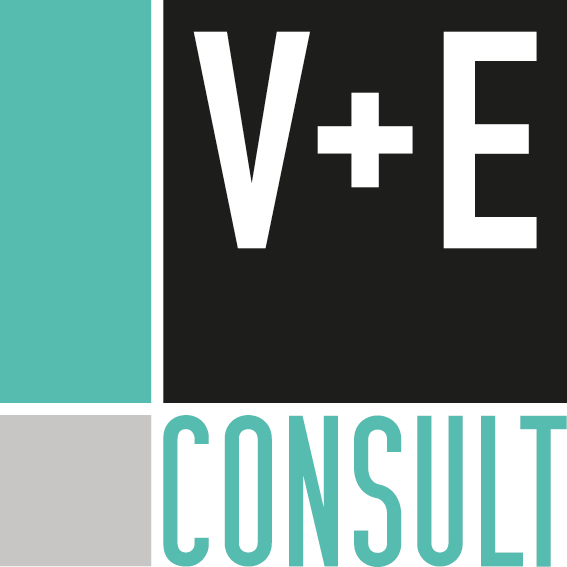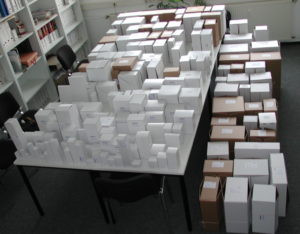Project examples
You want to get an idea of our work? Have a look at the following short reports of successful projects of V+E.
New packaging for gas discharge lamps from Osram
In the past, the very sensitive lamps were relatively elaborately packaged. The packaging was structured as follows:
The lamps were in an individual cushion packaging made of cardboard as inner protection.
The individual cushion packaging was diagonally in a folding box with a plug closure.
12 pieces of the folding boxes were wrapped in a collective carton of corrugated cardboard.
To protect the lamps, an additional ring-shaped corrugated cardboard box was inserted in the collective carton as an absorber.
Within the scope of a necessary new investment of a packaging machine the packaging was questioned and V+E Consult was commissioned to develop a new, more cost-effective packaging. A further development criterion was that the required shock absorption should be achieved by a suitable construction of the primary packaging, if possible, so that no additional padding is necessary in the outer packaging and the additional cardboard box can be omitted.
Result:
After a joint brainstorming session with Osram, V+E Consult developed and evaluated six alternative packaging proposals and produced samples. Alternative 2 – film blister packs – was selected. This packaging is a new deep-drawing process (the process has now been patented by Osram) in which the foil is drawn around the corresponding lamp and fixed in place. The blister is also given further deformation, which acts as an attenuator when inserted diagonally into the folding box and dampens the lamp when exposed to shock.
After several packaging tests (primarily drop tests) and further optimising, the new packaging was released and implemented in close cooperation (realisation team: Osram – V+E Consult). The implementation also included the project planning, design and implementation of a fully automatic packaging system (the system consists of 4 main machines from different suppliers. In the meantime, the packaging has proven itself in rough everyday operation and, which is of course very important for a packaging changeover, it was also positively received by the end customer.
Reduction of packaging complexity at Bosch
Particularly in the field of cardboard packaging, the costs per packaging are highly dependent on the run volume due to the high set-up costs of the manufacturers. In Bosch’s Automotive Aftersales division, a project to reduce the complexity of folding boxes made of solid and corrugated cardboard for the 48 Bosch plants in Europe was carried out very successfully in teamwork with Bosch employees.
The ratio was mainly achieved by
- Reduction of the number of different box dimensions and
- Centralisation and bundling of box purchasing to five manufacturers
- Selection of box constructions that can be filled with lower wage costs
More than half of the more than 500 different box dimensions were eliminated. In order to find out from the large number of box dimensions the boxes to be eliminated, large amounts of data had to be processed with specially written programs. The photo shows the new construction kit. Some box sizes are available with identical inner dimensions in different qualities and/or constructions, as for these sizes a great number of light as well as heavy products were found.
For the products whose previous box was cancelled, a special computer program was written, which selects the most suitable boxes for the product dimensions or the dimensions of the previous box from the box dimensions of the construction kit and graphically displays the future “air” in the new box. This program is now used in all European Bosch plants and has already found its way to South Africa.
However, the project has not only brought financial benefits, but has also made it possible to achieve a uniform appearance of the packaging, as only five manufacturers are involved in setting and monitoring ink tolerances. The extreme reduction in the number of carton suppliers is also a prerequisite for the planned measures to increase the counterfeit protection of the packaging.
Lamp relaunch at Varta requires new packaging
 The market relaunch of the lamp range had the aim of establishing Varta as a “category leader”. The assortment included about 50 different types of lamps and was divided into the following 5 marketing segments: Home, Work, Active, Mini and Kids.
The market relaunch of the lamp range had the aim of establishing Varta as a “category leader”. The assortment included about 50 different types of lamps and was divided into the following 5 marketing segments: Home, Work, Active, Mini and Kids.
The following criteria were defined for the development of the new packaging:
- The packaging should consistently reflect a high-quality concept across every type of product, shape and size.
- The packaging concept should allow for both batteries and rechargeable batteries not to be included with the respective lamp.
- The packaging should be easy for the consumer to open.
- The product should be visible through the packaging.
- The product should be in the foreground or highlighted by the packaging.
- The packaging should have anti-theft protection.
- Modular structure of the assortment, based on a few packaging sizes.
- The packaging dimensions should be adapted to the Varta battery blister with 8×12 cm (presentation on the Varta sales stand).
- It should be possible to implement the packaging concept for new products without much effort, i.e. as few product-specific components as possible.
Result:
Full plastic blister with an insert card curved in 2 directions, in 4 modular basic dimensions for all 50 lamp types. The easy opening of the package was achieved by spot welding the blister halves and an intervention at one corner. The package has the following advantages:
- High quality appearance
- Modular dimensions (in grid to battery blister) with advantages on the production machine, logistics and presentation on the Varta display.
- Due to the curvature of the blisters (to the front and in the middle area to the back) only one thermoforming mould is required for the back part for each format size (lower tooling costs and faster changeover times)
- By bending the (insert card lies against the back and runs behind the lamp) the cards can be made in uniform dimensions for all types of lamps (in the respective format).
During the project V+E Consult created samples for each development step, for market tests and as a guideline for the mould maker.


